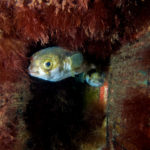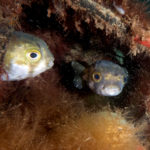Waste is a huge problem in the modern world, and nowhere seems more negatively impacted than the ocean. With plastic debris killing and maiming animals at alarming rates, campaigns to clean up the underwater world have proliferated. But is it always better to remove underwater trash? What if it’s become habitat for the local marine life? Below are a few points worth thinking about when it comes to underwater trash as habitat next time you take part in an ocean cleanup.
The material
To start with, we should (almost) always remove plastic from the ocean. We’ve all seen the damage plastic does to sea life and know how long it takes to break down. And once it does disintegrate, microplastics continue to wreak havoc on the marine environment. No one can argue that leaving plastics in the ocean is a good idea, with one, very specific situation as an exception — if you’re muck diving somewhere like Lembeh, and an octopus is living in a discarded plastic container, do you grab it and evict the animal, just to get that container out of the ocean? That question is up for debate, but many divers would choose to leave the animal alone.
But what about non-plastic waste, non-toxic and not dangerous to animals? Concrete blocks and old sections of wooden pier often quickly become artificial reefs that support all manner of sea creatures. Shopping carts often form artificial reefs with many noted examples of seahorse population recoveries in areas with old metal carts. Tires often become habitat as well, especially underneath piers. And the number of scuttled ships still being sunk to create artificial reef and diving playgrounds is ever-increasing. Glass bottles too create homes for blennies and other fish. If these bits of trash aren’t dangerous to animals, should we remove them?


The location
There are a few examples of areas we should totally clear of trash. First, pristine environments, relatively untouched by human interaction, and second, areas undergoing rehabilitation to return them to their natural state, are both examples of environments best cleaned up. But what about artificial habitats like piers and ports? These locations have already displaced most of the original marine life and dramatically altered the local ecosystem. People have cleared many harbors entirely of seagrasses, and thus displaced the multitude of animals that rely on it, simply by mooring too many boats.
Therefore, in these man-made environments, what does it matter if glass bottles or old timbers pile up? A fundamental principle in ocean ecology and ecosystem science is that surface area is at a premium. Often, a lack of solid substrate (i.e. rocky seafloors) prevents animal colonization. Australia’s Port Phillip Bay is a prime example. With fishermen removing the natural mussel and oyster beds decades ago, the substrate disappeared, and only sand remained. This has kept animals from recolonizing the area. Head to the piers around the bay, however and you will find abundant mussels and oysters clinging onto every solid surface. Many of these are artificial, and many are trash. Why remove these when the animals’ habitat is already destroyed and permanently altered? In environments that we have degraded so completely, why remove the animals that have made a home there and created a new ecosystem?
A mixed approach
When thinking about where to concentrate your ocean-cleanup efforts, consider whether the trash you’re removing has become an animal’s new home. If the trash in question is heavy enough that it forms part of the seafloor, and it’s unlikely to entangle or kill the local flora and fauna, perhaps you should leave it where it is. Doing so might provide a home for a sea creature that has lost its natural habitat due to that new marina development or port being installed. There’s no real difference between a pile of old glass bottles and or metal shopping carts and a shipwreck sunk for divers’ enjoyment — both change an already drastically altered environment. So, while underwater trash is almost always bad for the ocean, it can sometimes do more harm than good to remove it.
The post Underwater Trash as Habitat appeared first on Scuba Diver Life.
from Scuba Diver Life https://ift.tt/2Loyjwn
No comments:
Post a Comment